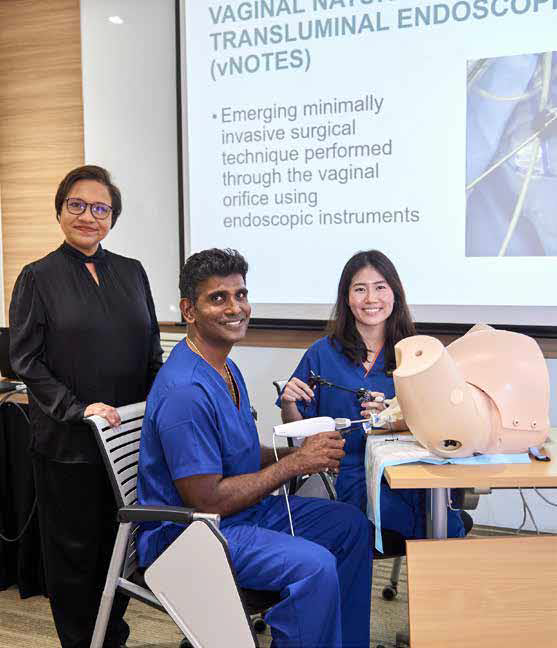
vNOTES surgical technique results in less pain, no visible scars, shorter hospital stay, and lower costs for patients.
Mdm Massita Surif was a natural candidate for hysterectomy using the vaginal natural orifice transluminal endoscopic surgery (vNOTES) technique, an increasingly popular surgical method.
The 50-year-old needed to remove her womb, which had ballooned to the size of a five-month pregnancy due to fibroids. The fibroids had caused heavy bleeding for years and triggered a stroke in 2018. Considered a high-risk patient, she also has multiple medical conditions and had undergone two Caesarian deliveries, suggesting possible tissue adhesions that can complicate surgery.
“I didn’t want to have open surgery because of my stroke, and I have a low pain threshold,” said Mdm Massita.
Traditionally hysterectomy is performed through open surgery, where a long cut is made across the abdomen to remove the womb. Open surgery allows surgeons to have a good view of the surgical area but it also involves bleeding, sometimes heavy, possible infections and complications. Removal can also be done by keyhole surgery, where a few small cuts are made for surgical instruments — tiny camera, forceps and scalpels — to be inserted. While the view of the surgical site may not be as good as in open surgery, minimally invasive surgery means less bleeding, smaller scars, and a quicker recovery.
Endoscopic surgery has advanced further, with few or no cuts needed, in procedures where the body’s natural openings are used instead. One of the latest methods is vNOTES, where instruments are inserted through the naturally elastic vagina to perform the procedure. “With vaginal hysterectomy, there are no external incisions, it's a shorter hospital stay, quicker recovery because of the lack of pain and fewer complications,” said Dr Yvonne Wong, Associate Consultant, Department of Obstetrics and Gynaecology (O&G), Singapore General Hospital (SGH).
Post-surgery, Mdm Massita had cramps for a week, very little bleeding and pain, and a fast recovery.
With advantages similar to other keyhole surgical techniques — perhaps more so — hysterectomy and other previously major surgeries are becoming day surgeries, said Dr Ravichandran Nadarajah, Senior Consultant, Department of O&G, SGH.
Indeed, vNOTES has become not just an improved keyhole technique, but one that is increasingly being used with complex or difficult cases — patients who are extremely obese, have multiple medical conditions or surgical adhesions, have cancer, or are elderly, said Dr Ravichandran. “With all the expertise and multidisciplinary support on SGH Campus, SGH has become a regional referral centre for more complicated cases. We have certainly handled the largest number of multispeciality complexities, including non-O&G cases,” he said.
In the first case of a non-gynaecological application of the vNOTES technique at SGH — and possibly in Singapore — Dr Joella Ang, SGH O&G Consultant, helped colorectal surgeons perform a partial colon removal by opening up the patient’s vaginal space.
KK Women’s and Children’s Hospital (KKH) is the leading tertiary centre for O&G cases, performing over 350 from March 2021, when the first such operation was done, to March 2024. In the same period, SGH performed 225, including 154 surgeries for benign indications, 66 for gynaecological oncology, and five for non-gynaecological oncology like breast cancer.
In 2023, KKH led SGH and the National Cancer Centre Singapore to be jointly accredited by the Royal College of Obstetricians and Gynaecologists as a speciality training centre in Gynaecological Oncology, the first outside Europe given the honour. SGH O&G was also ranked among the Top 100 in Newsweek’s Best Specialised Hospitals in O&G 2024.
Get the latest updates about Singapore Health in your mailbox! Click here to subscribe.













 Get it on Google Play
Get it on Google Play